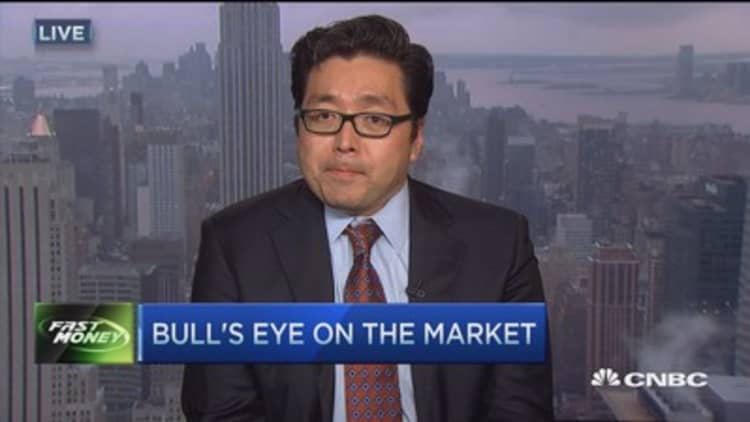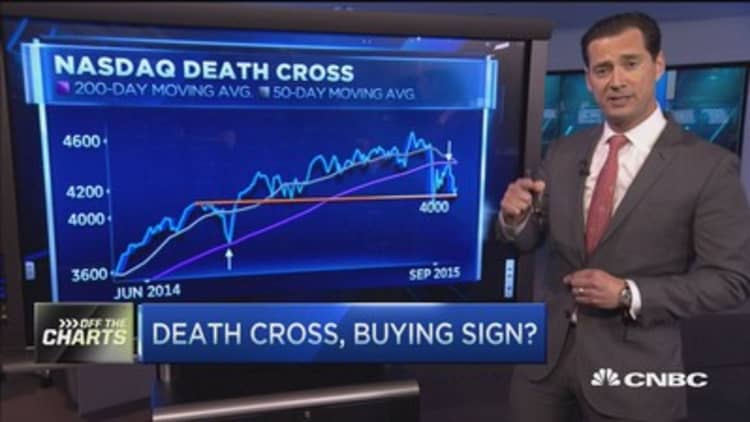


After the worst quarter in four years, most Wall Street strategists believe the stock market will bounce back in the fourth quarter even though the potential for headwinds is high.
Despite a nearly 2 percent rally Wednesday, the was down 6.9 percent for the third quarter, at 1,920, its worst performance since the 14.3 percent decline in the third quarter of 2011. Energy and materials were the worst performers, down 18 and 17 percent, respectively. But health care was also down double digits, losing more than 11 percent in its first negative quarter in nearly three years.
Read More CNBC Market Strategist Survey
Topping the list of worries is China, which clearly has a slowing economy but unclear how slow. The market also faces a possibly rocky earnings season, with profits expected to shrink about 3 percent, and traders wondering whether there will be a China chilling effect on corporate outlooks, either directly or indirectly. The other big factor hanging over markets continues to be the Fed which potentially could raise interest rates for the first time in nine years at one of two meetings — Oct. 28 or Dec. 16.
The fourth quarter is usually a positive time for stocks seasonally, so if the market does not rally as some analysts suspect, the debate will turn to whether 2016 will bring the first bear market in seven years. There are some analysts who expect the S&P 500 to have a negative year, even with the median year-end target of analysts surveyed by CNBC at 2,200.
"There's a decent amount of issues out there to be preoccupied with," said Paul Hickey, co-founder of Bespoke. "That being said, now that we're down 10 percent, there are a good amount of those concerns that are somewhat priced in. Analysts' sentiment going into the earnings season is negative. That's historically been a positive — fourth quarters' earnings season."
Some technicians say Wednesday's bounce in the S&P 500 after it edged near its August low Tuesday was a possible sign of bottoming for the market.
"We think most of the damage has been done in price; but more time (and volatility) may be needed before the bottoming process ends," wrote Charles Schwab analysts Wednesday.
Mark Newton, chief technical analyst at Greywolf Execution Partners, believes a bottom is several days away, and he sees a year-end rally. But he also said the market may finish the year below its 2014 close of 2,058. And even though he expects another move higher, he is growing more cautious on stocks and says 2016 could usher in a bear market.
Read MoreStocks rally into quarter end but now what
"I think we're in the process of peaking," he said.
Newton said the big corrections in some stocks and sectors this summer was a "stealth bear market."
"The levels you're seeing in momentum are lower than they've been in the last five years," he said.
U.S. economic reports will continue to dominate trading as investors watch to see whether the economy remains strong enough for the Fed to hike rates. This Friday's September jobs report will be a key since it is the last employment report the Fed will see before its October meeting. The market sees a low probability of a Fed hike in October, but the central bank has signaled it is possible.
The Fed will also watch consumer driven data, so even Thursday's car sales will be important and they could show some of the best sales in a decade. There is also ISM manufacturing data, construction spending and weekly jobless claims Thursday. Third-quarter GDP will be reported on Oct. 29, after the Fed meeting, and it is expected to be about 2.5 percent, after the second quarter's 3.9 percent growth.
Read MoreThis chart could signal a bottom for stocks
As for China, its GDP is reported in the third week of October, and that should be a focus for the markets as traders continue to hang on every bit of Chinese data, especially after the Fed pointed to China weakness as a reason it held off hiking rates in September.
"What I am concerned about is if China slows meaningfully. If it really gets meaningfully worse," said Tobias Levkovich, chief US equities strategist at Citigroup. Levkovich does not expect a much weaker China, but he said Chinese growth is probably several percent lower than the official 7 percent it last reported.
Levkovich, however, says he expects China is getting priced in, and has been since the market's recent peak on Aug. 17. China is a concern "nobody can get their hands around ... nobody knows what's going on in China," he said.
But he sees a market rebound in fourth quarter, which should send stocks higher toward his year-end target of 2,200 on the S&P 500. One big positive is that credit market remain in good shape, unlike other times of market stress that preceded recessions.
Read MoreJack Ma to US: Quit worrying so much about China
Geopolitical concerns will continue to hang over the market, as they always do, and Levkovich pointed to uncertainty surrounding a number of elections — in Portugal, Spain, Turkey and Canada. The Spanish election could be impacted by the Catalan efforts to split off from Madrid. Elections in Turkey and even Canada could have uncertain outcomes, possibly resulting in hung parliaments, according to Levkovich.
Traders will continue to watch developments in Syria, with Russia on Wednesday conducting its first airstrikes purportedly against ISIS. However, U.S. officials were skeptical of the strikes, and there could continue to be tensions between the U.S., Russia, and other parties.
Another big event for markets will be Dec. 11, the date Congress would have to address the spending resolution it temporarily approved to keep the government running. At the same time, the debt ceiling limit will be close at hand and it could again be a point of contention in Congress.
"We're going to have the debt ceiling and the spending authorization," said Marc Chandler, head of foreign exchange strategy at Brown Brothers Harriman. "What's interesting is the FOMC meeting is a week later. If the government is closed, it will be hard to imagine them cutting rates." The fear is Congress could allow the U.S. to default but analysts do not place a high probability on that.
Read MoreCarl Icahn: I think markets are overpriced, earnings are misstated
Central bank activity could be running high in the fourth quarter, Chandler said. "A lot of people focus on the end of October. That's when Japan last year increased the size of its QE. They have another window of possibly expanding QE," he said. "Many people expect the ECB (European Central Bank) to announce an extension of its QE."
Another big event this quarter is OPEC's meeting Dec. 4. The cartel so far is not expected to change its policy of letting market forces decide the price of oil. OPEC's efforts to hurt high-cost producers appear to be succeeding with U.S. production flattening out in recent weeks. West Texas Intermediate oil futures lost 24 percent in the third quarter, with WTI at about $45 per barrel.
According to Bespoke, history shows fourth quarters are mostly positive for stocks, but the odds were lower when the S&P was negative year to date after the third quarter. It is currently down 6.7 percent for the year.
Since 1930, when the S&P 500 was lower on the year at the end of the third quarter, the fourth quarter averaged a decline of 0.65 percent although it gained 53 percent of the time. When the S&P was positive after the third quarter, the fourth quarter was positive 82.5 percent of the time, with an average return of 4.3 percent.
Read More Job creation gets big boost from big business: ADP


